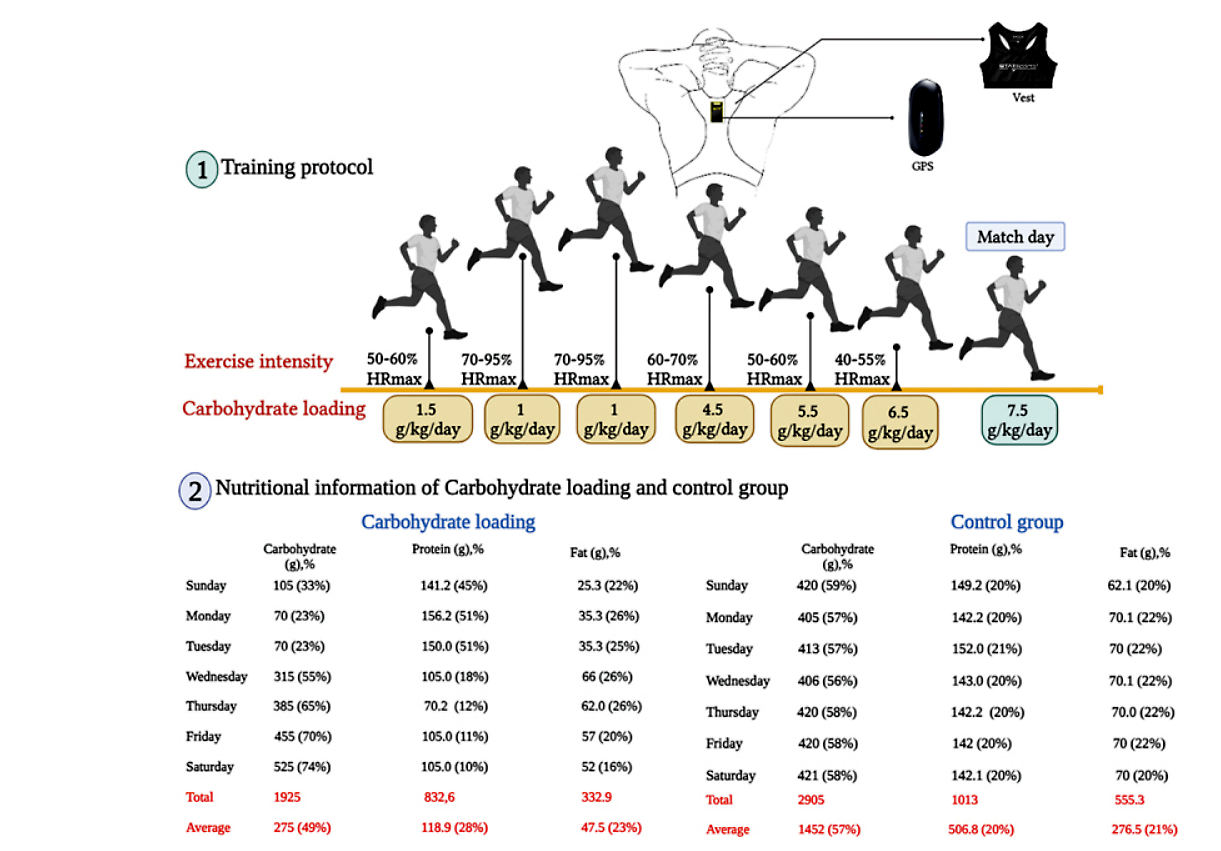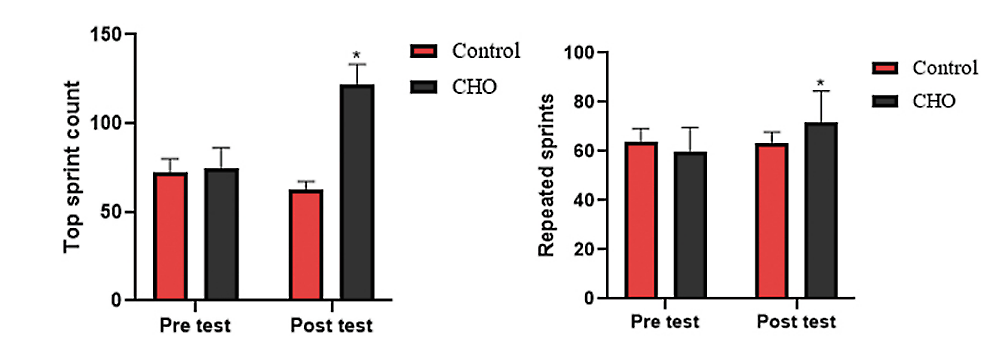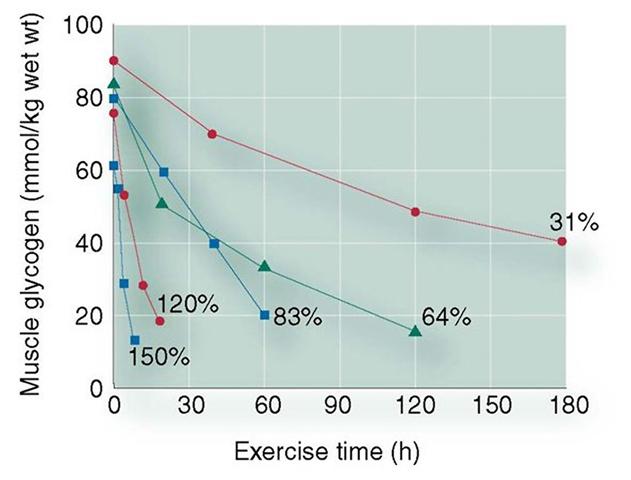You are viewing 1 of your 1 free articles. For unlimited access take a risk-free trial
Soccer performance: to load or not to load?
SPB looks at some new and fascinating new research on pre-match carbohydrate intake and soccer performance
Assuming your diet is healthy and you’re drinking ample fluid, it’s no exaggeration to say that when it comes to endurance, your carbohydrate nutrition can make the difference between merely adequate and truly excellent performance. That’s because carbohydrate can be considered as your body’s 5-star fuel. Consuming the right amount of the right type of carbohydrate at the right time can dramatically extend your endurance and delay fatigue.
The fundamental importance of carbohydrate
The study of carbohydrate metabolism in relation to the field of sport and exercise is an area of investigation that is now over 100 years old. It was almost a century ago, when researchers first demonstrated that fatigue occurs earlier when subjects consume a low-carbohydrate diet (as compared with a high-carbohydrate diet) in the days preceding an exercise(1). Shortly afterwards, researchers also observed that runners who completed the 1923 Boston marathon exhibited hypoglycaemia (low blood sugar) immediately post-exercise, thus suggesting that low carbohydrate availability may be linked to fatigue(2).
These very early studies provided the initial evidence that carbohydrate was an important fuel source for sustaining exercise performance. However, it wasn’t until the development of muscle biopsy techniques in the late 1960s that sports science researchers were able to fully grasp the fundamental importance of carbohydrate for endurance exercise performance. In a series of studies by Scandinavian researchers, scientists discovered three key principles, upon which our current-day understanding is built upon(3-6). These key principles are as follows:
I. Muscle glycogen (stored muscle carbohydrate – the body’s 5-star fuel for high-intensity exercise performance) is depleted during exercise in an intensity dependent manner (see figure 1).
II. High-carbohydrate diets increase muscle glycogen storage and subsequently improve exercise capacity.
III. Depleting muscle glycogen with prior exercise then consuming a high-carbohydrate diet can boost muscle glycogen storage above and beyond normal storage levels.
A half a century later, these three principles still serve as the foundations for the current recommendations for modern-day sports nutrition practice(7).
Figure 1: Exercise intensity and glycogen depletion*
As the percentage of maximum sustainable intensity rises, the time taken to deplete glycogen stores diminishes. At 64% maximum, glycogen levels have dropped to 20mmol/kg after 105 minutes. At 83% of maximum, this takes just 60 minutes, while at 120% of maximum, it takes a mere 20 minutes.
*Adapted from Jeukendrup and Gleeson 2004; Sport Nutrition: ‘An introduction to energy production and performance’.
Loading up for competition
Muscle glycogen storage is comparatively limited; fully loaded, your muscles can only store around 400g or so of glycogen - enough to supply around 2-3 hours’ worth or so of intense exercise. After this point, increasing amounts of energy have to be derived from fat, which is a less efficient process requiring more oxygen to liberate muscular energy. This inevitably results in greater perceived effort for at sub-maximal pace and a slower maximum pace. It follows therefore that all other things being equal, the more muscle glycogen you have successfully stored by ‘carbohydrate loading’ before training or a long event, the longer you’ll be able to maintain your exercise intensity before fatigue sets in.
This explains the principle of ‘carbohydrate loading’, where athletes tailor their carbohydrate nutrition prior to an event to maximize glycogen stores during that event. The simplest way to do this is to ensure a high carbohydrate intake in the days preceding the event while simultaneously reducing high-intensity exercise (which predominantly burns carbohydrate for fuel). However, this loading strategy can be ‘supercharged’ by maintaining a low carbohydrate intake during high-intensity training 3-4 days prior to an event followed by the consumption of a high-carbohydrate diet while undertaking only low-intensity exercise, which achieves ‘glycogen supercompensation’(8). The important aspect of this approach is that it doesn’t just increase glycogen storage levels back to normal – it actually elevates it to a supra-normal level!
Can loading benefit a wider range of athletes?
Due to the need to produce energy at a high rate for durations of over two hours, the practice of carbohydrate loading became commonplace among marathon and ultramarathon runners. There was good reason too; studies showed that carbohydrate ’loading’ can enhance marathon performance by allowing the competitor to run at their optimal pace for a longer period before fatiguing. For well trained runners, this was achieved by tapering exercise over the final days before the marathon, and ensuring carbohydrate intakes of 10-12 grams per kilo per day over the 36-48 hours prior to the race(9).
The loading recommendations above have since become fairly mainstream for all endurance athletes performing in events of two hours duration or more – eg cyclists, swimmers, triathletes etc. One question that remains relatively unanswered however, whether these loading recommendations can benefit other sportsmen and women whose events, while not requiring the same level of endurance demand, nevertheless could benefit from optimal carbohydrate loading (or even super-compensated levels of loading)?
One example is soccer. Although lasting only 90 minutes with a 15-minute half-time window where refuelling can take place, the energy demands are still considerable. This is because the typical running intensities required over the 90 minutes entail involve many bouts of high-speed and sprint running, especially for midfield players(10). And while there are general sports nutrition recommendations based on ensuring ample pre-match carbohydrate intake, specific loading recommendations for soccer players are limited.
New research for soccer
For some answers and recommendations on carbohydrate loading for soccer players, we can turn to brand new research from Iran. Published last month in the Journal of the International Society of Sports Nutrition, this study investigated whether a specific pre-match carbohydrate loading regime could improve the performance of elite soccer players(11).
What they did
One week before a match, 22 Iranian Premier League soccer players were divided into a carbohydrate-loading group and control group. In the seven days run up to the match, both groups undertook exactly the same training load (monitored using GPS and heart rate data). In brief, this consisted of:
· Sunday - 70 minutes of physical exercise, the intensity of which varied between 50–60% of HRmax. The training on this day included technical and tactical drills, including 4 × 4 attack and defense. The total running distance run was 2–4 km according to the GPS data.
· Monday and Tuesday - mornings with high-intensity interval training (HIIT) and evenings with technical drills. The morning HIIT was performed at an intensity of 80–95% of HRmax consisting of repeated sprints. The evening exercise consisted of 70 min of tactical attack and defense drills and teamwork exercises at an intensity of 70–95% of HRmax with a total GPS run distance of 7–12 km.
· Wednesday - technical and tactical drills, such as 2 vs. 2 games, with a GPS run distance of 6–9 km at an intensity of 60–70% of HRmax.
· Thursday - theoretical and tactical drills with a GPS run distance of 3–5 km at an intensity of 50–60% of HRmax.
· Friday - 40 minutes of side crosses, free kicks and penalties at an intensity of 40–50% of HRmax with a GPS run distance of 2–3 km.
The key difference however was that the carbohydrate loading group restricted their carbohydrate intake to 1.5 grams per kilo per day for the first three days, and then carbohydrate intake was considerably increased - up to 7.5 grams per kilo per day on the day of the match (see figure 2), during which performance was analyzed using GPS data. The control group performed exactly the same exercise training but maintained their habitual carbohydrate intake of 5-6 grams per kilo per day.
Figure 2: Carbohydrate depletion and loading protocol in the carbohydrate loading group

During the match itself, various performance parameters were measured to determine when the loading protocol had helped or hindered performance. Measurements included:
· Average total match running distance per team. Only speeds over 3 meters per second (m/s) were considered running.
· The average maximum sprint speed. To evaluate the maximal sprinting speed, the maximum running speed was defined as 20 to 40 meters.
· The number of sprints with a speed over 4 m/s (top sprint count.)
· The number of repeated top sprints over 4 m/s within 90 s (repeated sprint count).
· The player load (PL), defined as the amount of accumulated load a player experienced during the game based on accelerometry.
What they found
The results were surprising to say the least. While the players in the carbohydrate-loading group consumed significantly fewer amount calories from carbohydrates compared to the control group over the 7-day period, they actually performed better than the control group. The better performance of the carbohydrate loading group was highlighted by the results of running distance and maximum speed; the players in this group were able to run longer distances and reach higher maximum speeds than the control group. Another key finding was that the players in the carbohydrate loading group showed an increase in top and repeated sprint counts compared to the control group (see figure 3). Moreover, the players in the carbohydrate loading group experienced less perceived effort and had a reduced energy cost while maintaining their performance levels.
Figure 3: Differences in the top and repeated sprint counts between groups

Implications for soccer and other field sports players
These results were surprising and have implications for soccer and other field sport athletes. This data suggests that a 4-day period of carbohydrate depletion followed by a higher than normal carbohydrate intake in the three days run up to a match can produce better performance than simply maintaining a reasonably carbohydrate-rich diet (55-60% of daily calorie intake) through the same period.
What is particularly interesting is the finding on the number and quality of sprints performed in the match. Research shows that when you take professional and amateur soccer players who are matched for aerobic fitness, the professional players invariably outperform the amateurs in tests of high-intensity intermittent running capacity and repeated sprint capability(12). This really matters because it is nearly always as a result of sprint efforts in a game that goals are scored (or conceded).
If you’re a soccer (or rugby, basketball, hockey etc) player, should you try this depletion loading protocol before a match? The results are certainly persuasive – ie that it could be worthwhile. However, this is just one study and ideally we would need to see more data confirming these findings before being totally confident. Having said that, there’s nothing to lose by experimenting with the protocol outlined above. You might find it yields real benefits! Just be mindful that the during the 4-day depletion phase, the total volume of training was actually fairly modest (although it did include some high-intensity intervals). One caveat however would be not to ’experiment’ before an all-important match. Try this protocol first and see how you perform in a friendly or training match. Once you’re sure it works for you, you can introduce it in the run up to more important matches.
Remember too that once carbohydrate intake is bumped up after the first three days, it should be at a level that is higher than your average carbohydrate intake – ideally around 70-75% of your total daily calorie intake. This can be easily calculated by carefully monitoring what you eat and using the fact that each gram of fat, protein and carbohydrate contains 9, 4 and 4 calories respectively. Ensure too that you are consuming around 7.5 grams of carbohydrate per kilo of bodyweight per day – that’s around 600 grams per day for an 80kg athlete.
References
1. Biochem. J. 1920, 14, 290–363
2. J. Am. Med. Assoc. 1924, 82, 1778–1779
3. Acta Physiol. Scand. 1967, 71, 140–150
4. Nature 1966, 210, 309–310
5. Scand. J. Clin. Lab. Investig. 1966, 18, 16–20
6. Acta Physiol. Scand. 1967, 71, 129–139
7. Position of the Academy of Nutrition and Dietetics, Dietitians of Canada, and the American College of Sports Medicine: ‘Nutrition and athletic performance’. J. Acad. Nutr. Diet. 2016, 116, 501–528
8. Int J Sport Nutr Exercise Metab. 2018;28:451–463
9. Sports Med. 2007;37(4-5):344-7
10. ’Managing high-speed running load in professional soccer players’ SPSR 2019 March (53) volume 1
11. J Int Soc Sports Nutr. 2023; 20(1): 2258837
12. J Sports Med Phys Fitness 2012; 52: 245 – 254
Newsletter Sign Up
Testimonials
Dr. Alexandra Fandetti-Robin, Back & Body Chiropractic
Elspeth Cowell MSCh DpodM SRCh HCPC reg
William Hunter, Nuffield Health
Newsletter Sign Up
Coaches Testimonials
Dr. Alexandra Fandetti-Robin, Back & Body Chiropractic
Elspeth Cowell MSCh DpodM SRCh HCPC reg
William Hunter, Nuffield Health
Keep up with latest sports science research and apply it to maximize performance
Today you have the chance to join a group of athletes, and sports coaches/trainers who all have something special in common...
They use the latest research to improve performance for themselves and their clients - both athletes and sports teams - with help from global specialists in the fields of sports science, sports medicine and sports psychology.
They do this by reading Sports Performance Bulletin, an easy-to-digest but serious-minded journal dedicated to high performance sports. SPB offers a wealth of information and insight into the latest research, in an easily-accessible and understood format, along with a wealth of practical recommendations.
*includes 3 coaching manuals
Get Inspired
All the latest techniques and approaches
Sports Performance Bulletin helps dedicated endurance athletes improve their performance. Sense-checking the latest sports science research, and sourcing evidence and case studies to support findings, Sports Performance Bulletin turns proven insights into easily digestible practical advice. Supporting athletes, coaches and professionals who wish to ensure their guidance and programmes are kept right up to date and based on credible science.











